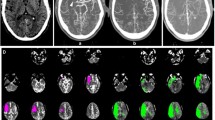Abstract
Background
Intravenous tPA is the standard treatment for acute ischemic stroke within 4.5 hours of symptom onset. Neuroradiological selection is currently based upon non-contrast- brain CT scan (NCCT).
Aims
To verify, in an “expert-opinion setting”, the possible usefulness of CT perfusion (CTP) in decision-making toward i.v. thrombolysis.
Patients and method
One hundred and three consecutive patients with acute ischemic stroke who underwent NCCT and CTP were re-evaluated by an expert in cerebrovascular disease, to verify if adding CTP information would have changed expert’s opinion.
Results
After CTP, a definitive decision was made for 20 more patients, changing the proportion of patients candidate to i.v. tPA from 44% to 51%, and reducing uncertainty from 29% to 10%. CTP results were useful inmilder stroke (p = 0.01).
Conclusions
In a “real world” setting, CT perfusion could be useful for clinical decision, in particular for milder stroke.
Similar content being viewed by others
References
Wardlaw JM, Murray V, Berge E, del Zoppo GJ (2014) Thrombolysis for acute ischaemic stroke. Cochrane Database Syst Rev 29(7):CD000213
Emberson J, Lees KR, Lyden P et al (2014) Effect of treatment delay, age, and stroke severity on the effects of intravenous thrombolysis with alteplase for acute ischaemic stroke: a meta-analysis of individual patient data from randomised trials. Lancet 384(9958):1929–1935
Berkhemer OA, Fransen PS, Beumer D et al (2015) A randomized trial of intraarterial treatment for acute ischemic stroke. N Engl J Med 372(1):11–20
Dippel DW, Majoie CB, Roos YB et al (2016) Influence of device choice on the effect of intra-arterial treatment for acute ischemic stroke in MR CLEAN (multicenter randomized clinical trial of endovascular treatment for acute ischemic stroke in the Netherlands). Stroke 47(10):2574–2581
Mr Witness trial https://clinicaltrials.gov/ct2/show/NCT01282242
Hungerford JP, Hyer M, Turk AS et al (2016) Impact of ASPECT scores and infarct distribution on outcomes among patients undergoing thrombectomy for acute ischemic stroke with the ADAPT technique. J Neurointerv Surg
Minnerup J, Broocks G, Kalkoffen J et al (2016) Computed tomography-based quantification of lesion water uptake identifies patients within 4.5 hours of stroke onset: a multicenter observational study. Ann Neurol 80(6):924–934
Bivard A, Huang X, McElduff P et al (2016) The Impact of CT perfusion imaging on the response to tenecteplase in ischemic stroke. Analysis of two randomized controlled trials. Circulation
Del Sette M, Eliasziw M, Streifler JY et al (2000) Internal Borderzone infarction: a marker for severe stenosis in patients with symptomatic internal carotid artery disease. Stroke 31:631–636
Streifler JY, Eliasziw M, Benavente OR et al (2003) Development and progression leukoaraiosis in patients with ischemic events and carotid artery disease. Stroke 34:1913–1917
Novotná J, Kadlecová P, Czlonkowska A et al (2014) Hyperdense cerebral artery computed tomography sign is associated with stroke severity rather than stroke subtype. J Stroke Cerebrovasc Dis 23(10):2533–2539
Nighoghossian N, Abbas F, Cho TH et al (2016) Impact of leukoaraiosis on parenchymal hemorrhage in elderly patients treated with thrombolysis. Neuroradiology 58(10):961–967
Morelli N, Rota E, Immovilli P et al (2015) Computed tomography perfusion-based thrombolysis in wake-up stroke. Intern Emerg Med 10(8):977–984
Benson JC, Payabvash S, Mortazavi S et al (2016) CT perfusion in acute lacunar stroke: detection capabilities based on infarct location. AJNR Am J Neuroradiol 37(12):2239–2244
Wardlaw JM, Carpenter T, Sakka E et al (2014) Imaging perfusion deficits, arterial patency and thrombolysis safety and efficacy in acute ischaemic stroke. An observational study of the effect of advanced imaging methods in the third international stroke trial (IST-3), a randomised controlled trial. Southampton (UK): NIHR Journals Library, Jul
McDonald JS, Fan J, Kallmes DF, Cloft HJ (2014) Pretreatment advanced imaging in patients with stroke treated with IV thrombolysis: evaluation of a multihospital data base. AJNR Am J Neuroradiol 35(3):478–481
Bivard A, Levi C, Krishnamurthy V et al (2015) Perfusion computed tomography to assist decision making for stroke thrombolysis. Brain 138(Pt 7):1919–1931
Author information
Authors and Affiliations
Corresponding author
Ethics declarations
All clinical and neuroradiological data are stored in the local database.
Conflict of interest
The authors declare that they have no conflict of interest.
Rights and permissions
About this article
Cite this article
Strada, L., Streifler, J.Y., Del Sette, B. et al. Is CT perfusion helpful in the treatment allocation of patients with acute ischemic stroke? An expert-opinion analysis. Neurol Sci 38, 1771–1777 (2017). https://doi.org/10.1007/s10072-017-3051-1
Received:
Accepted:
Published:
Issue Date:
DOI: https://doi.org/10.1007/s10072-017-3051-1




